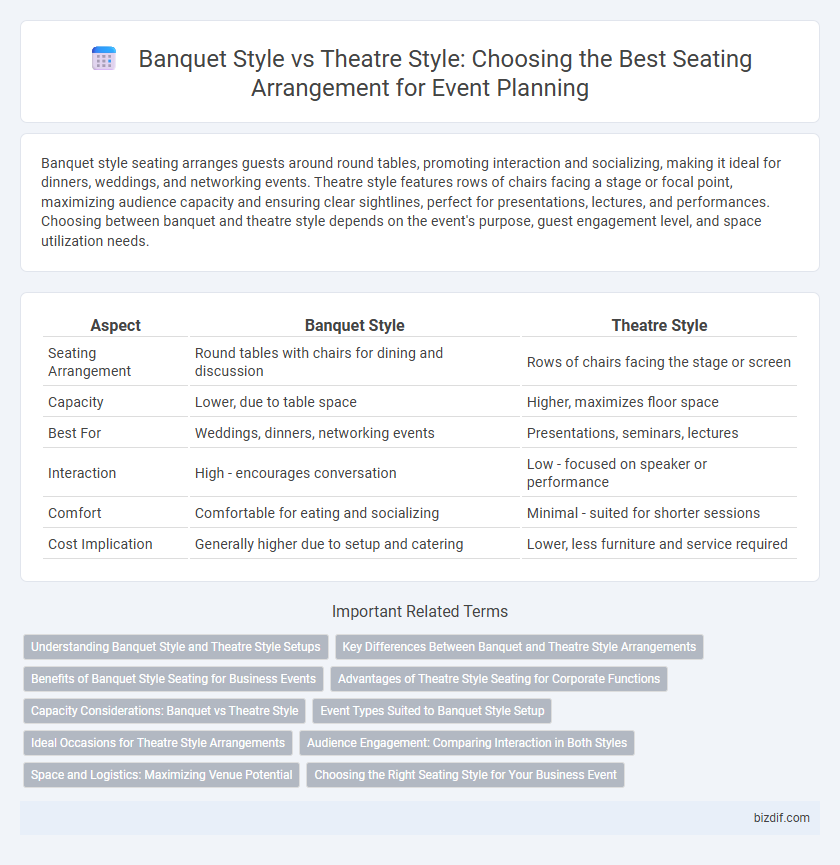Banquet style seating arranges guests around round tables, promoting interaction and socializing, making it ideal for dinners, weddings, and networking events. Theatre style features rows of chairs facing a stage or focal point, maximizing audience capacity and ensuring clear sightlines, perfect for presentations, lectures, and performances. Choosing between banquet and theatre style depends on the event's purpose, guest engagement level, and space utilization needs.
Table of Comparison
| Aspect | Banquet Style | Theatre Style |
|---|---|---|
| Seating Arrangement | Round tables with chairs for dining and discussion | Rows of chairs facing the stage or screen |
| Capacity | Lower, due to table space | Higher, maximizes floor space |
| Best For | Weddings, dinners, networking events | Presentations, seminars, lectures |
| Interaction | High - encourages conversation | Low - focused on speaker or performance |
| Comfort | Comfortable for eating and socializing | Minimal - suited for shorter sessions |
| Cost Implication | Generally higher due to setup and catering | Lower, less furniture and service required |
Understanding Banquet Style and Theatre Style Setups
Banquet style setups feature round tables that promote social interaction and dining experiences, ideal for events like weddings and gala dinners. Theatre style arrangements consist of rows of chairs facing a stage or speaker, maximizing seating capacity for presentations and lectures. Choosing between banquet and theatre styles depends on event goals, space constraints, and desired attendee engagement.
Key Differences Between Banquet and Theatre Style Arrangements
Banquet style arrangements feature round tables that promote interaction and dining, accommodating guests for meals and socializing, typically seating 6 to 12 people per table. Theatre style setups consist of rows of chairs facing a stage or presentation area, maximizing audience capacity and focusing on visual and auditory engagement without tables. Key differences include space utilization, purpose--banquets emphasize comfort and socializing while theatre style prioritizes maximum seating and clear visibility for presentations or performances.
Benefits of Banquet Style Seating for Business Events
Banquet style seating promotes networking and collaboration by encouraging face-to-face interaction among attendees, making it ideal for business events focused on relationship-building. This layout allows for comfortable dining alongside presentations, facilitating a seamless blend of socializing and professional engagement. The arrangement also supports a more relaxed atmosphere, enhancing attendee satisfaction and participation during meetings and corporate celebrations.
Advantages of Theatre Style Seating for Corporate Functions
Theatre style seating maximizes space efficiency by allowing more attendees to be accommodated in a given area, making it ideal for large corporate presentations and product launches. It enhances visibility and focus, as all seats face the stage or speaker, facilitating better audience engagement and information retention. This seating arrangement also simplifies logistics and reduces setup time, contributing to a streamlined event flow and cost-effective planning.
Capacity Considerations: Banquet vs Theatre Style
Banquet style seating accommodates fewer guests per square meter due to the inclusion of round tables and ample space for dining, typically seating 60-80% of the capacity compared to theatre style. Theatre style maximizes room capacity by arranging chairs in rows without tables, making it ideal for presentations and large audiences, often increasing guest capacity by up to 40%. Event planners must weigh the trade-off between comfort and capacity, choosing banquet style for interactive meals and theatre style for maximizing attendance in limited spaces.
Event Types Suited to Banquet Style Setup
Banquet style setup is ideal for events that involve dining, such as weddings, gala dinners, and award ceremonies, where guests can comfortably enjoy meals while networking or celebrating. This arrangement supports social interaction and provides ample space for table service, making it suitable for corporate dinners, charity events, and family reunions. Its round tables enhance guest engagement, facilitating conversations and creating a more intimate atmosphere compared to theatre style setups.
Ideal Occasions for Theatre Style Arrangements
Theatre style arrangements excel in events where audience focus on a single speaker or presentation is crucial, such as conferences, seminars, and lectures. This setup maximizes seating capacity while maintaining clear sightlines to the stage, making it ideal for keynote addresses and panel discussions. It is less suited for interactive dining experiences, instead prioritizing efficient space utilization and audience engagement with visual and audio content.
Audience Engagement: Comparing Interaction in Both Styles
Banquet style seating fosters higher audience engagement by encouraging face-to-face interaction and group discussions, making it ideal for collaborative events and social gatherings. Theatre style seating maximizes capacity and focuses attention on the stage, but limits personal interaction since attendees face forward in rows. Event planners select banquet style for interactive experiences, while theatre style suits presentations and lectures where audience participation is minimal.
Space and Logistics: Maximizing Venue Potential
Banquet style seating maximizes social interaction and requires ample space for round tables and service access, often reducing overall capacity but enhancing guest comfort. Theatre style optimizes space by arranging chairs in rows, increasing audience capacity significantly and streamlining logistics for presentations and performances. Selecting the appropriate setup depends on balancing venue dimensions, event objectives, and movement flow to maximize available space and logistical efficiency.
Choosing the Right Seating Style for Your Business Event
Selecting the appropriate seating style for your business event significantly impacts attendee engagement and comfort. Banquet style encourages interaction through round tables, ideal for networking or collaborative meetings, while theatre style maximizes space efficiency with rows facing the stage, perfect for presentations or keynote speeches. Assess the event's objectives and participant needs to choose between banquet style's social atmosphere and theatre style's formal focus.
Banquet style vs theatre style Infographic

 bizdif.com
bizdif.com